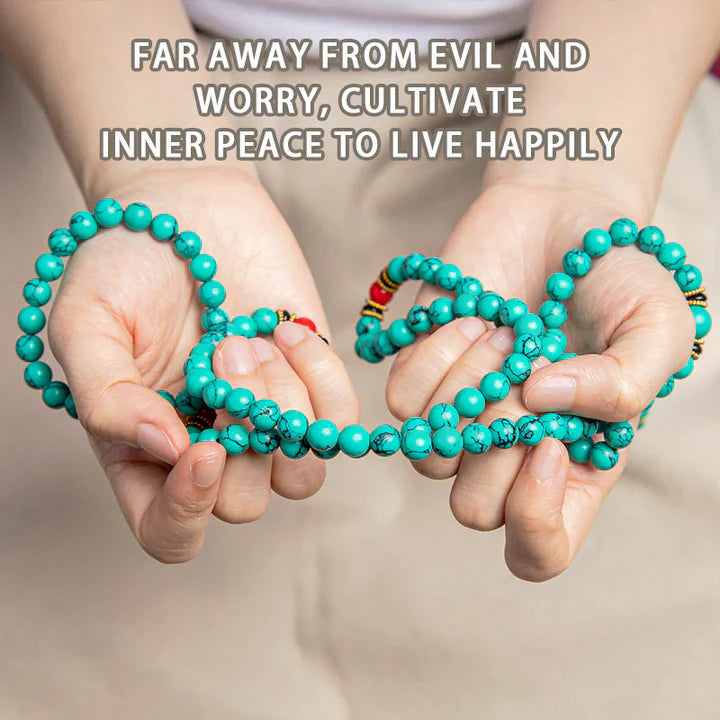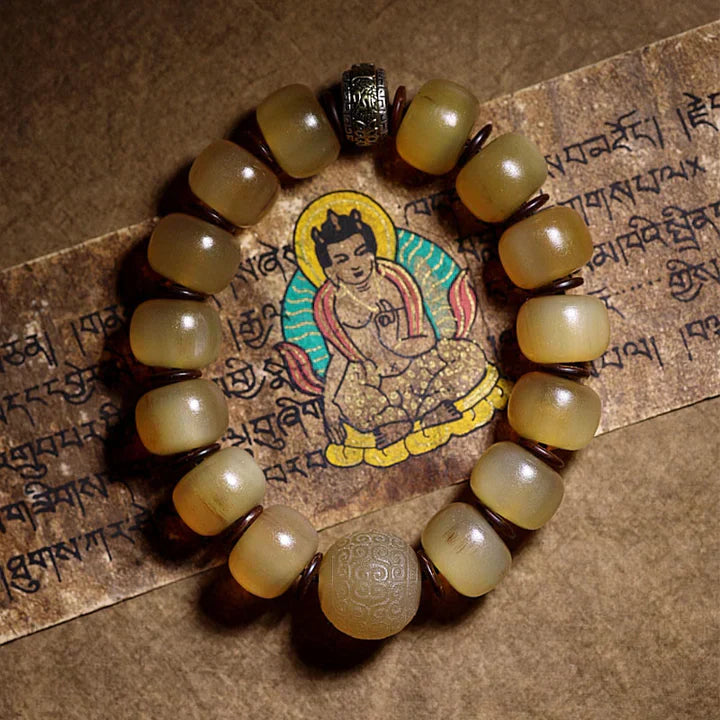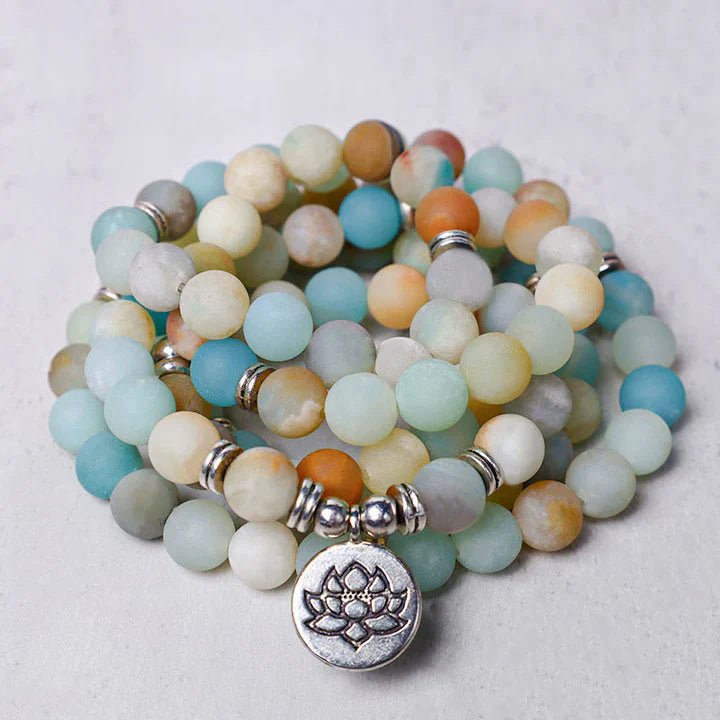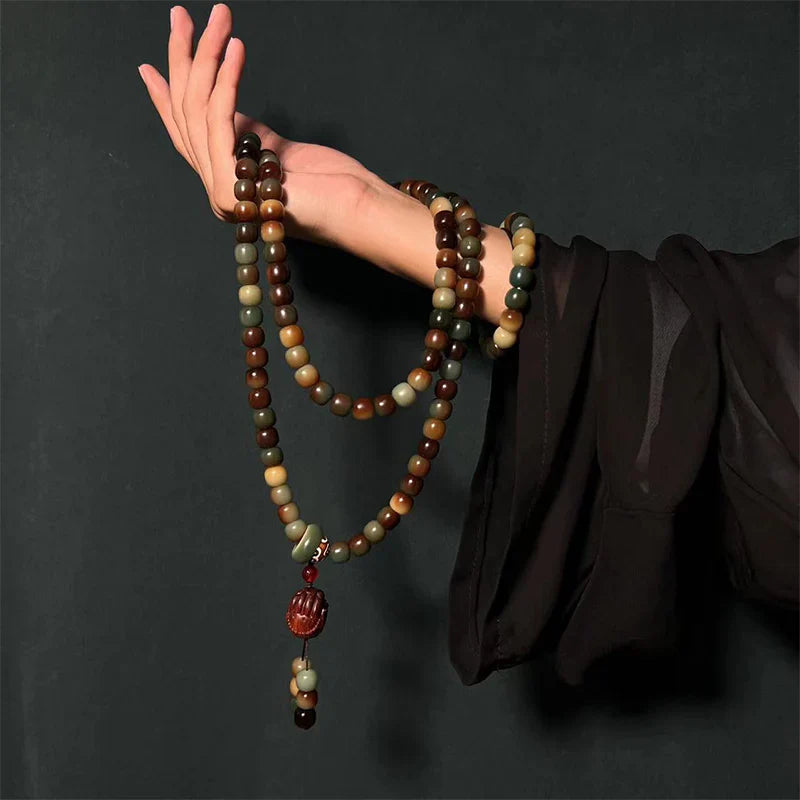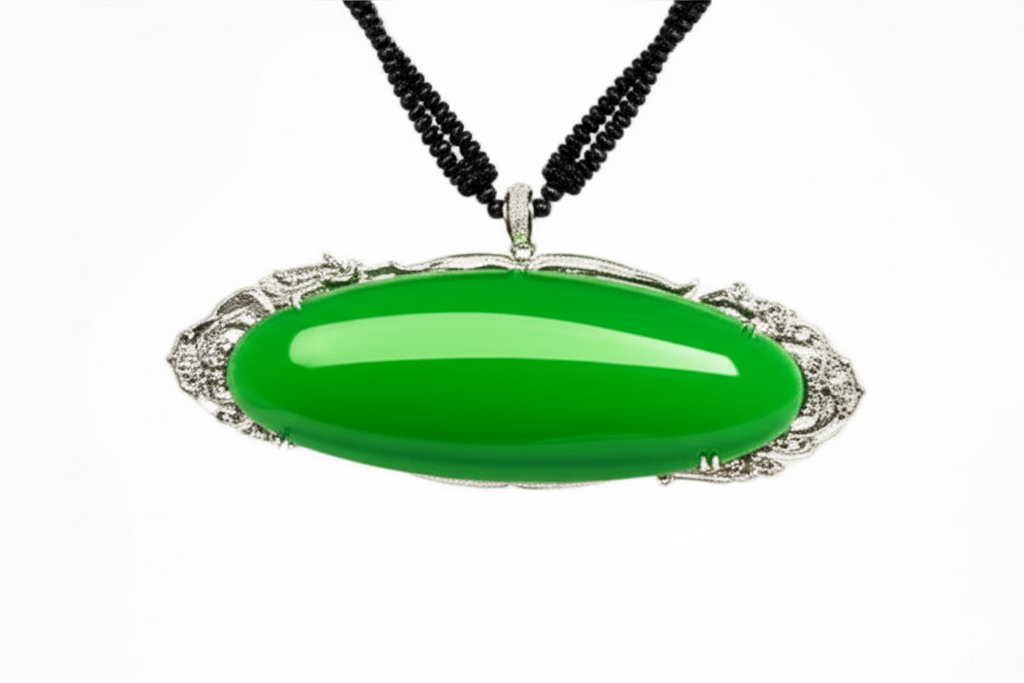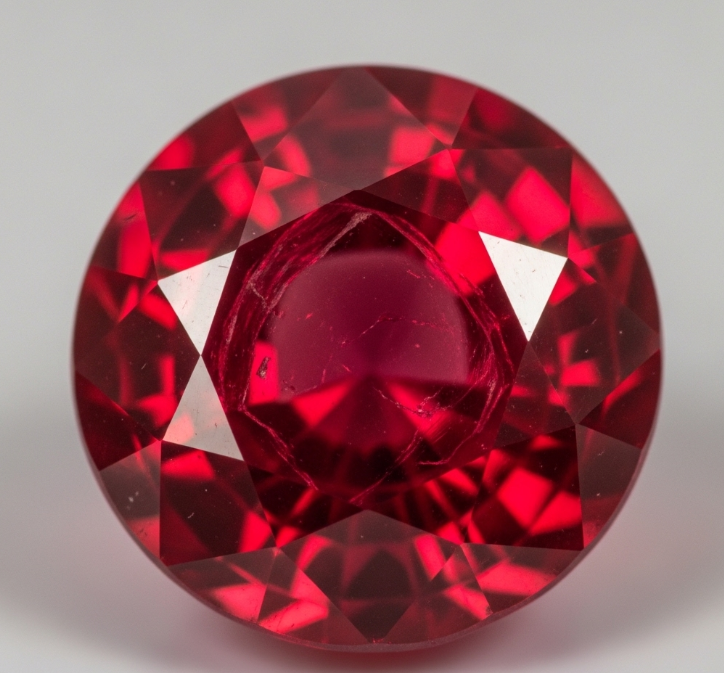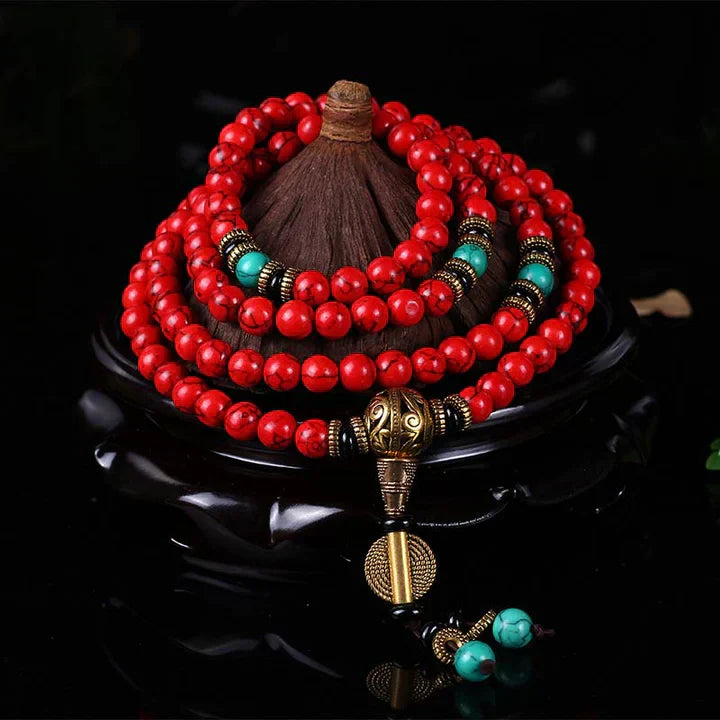
How many beads are on a rosary bracelet?
Rosary beads, as objects of faith and spiritual sustenance, have evolved over millennia, evolving from primarily religious tools to bracelets imbued with both cultural significance and decorative value. The number of beads isn't arbitrary; each number holds profound religious philosophy, cultural traditions, and spiritual meaning. Furthermore, rosary bracelets, crafted from diverse materials and using varying techniques, have developed unique aesthetic codes over time. This article will examine the cultural origins of rosary bracelets and delve into the symbolic meaning of the number of beads. It will also explore common materials, wearing etiquette, and modern evolution, providing a comprehensive understanding of this object of both spiritual and practical value.
I. The Cultural Origins of Rosary Bracelets: From a Tool of Faith to a Practical Accessory
The origins of rosary beads can be traced back to ancient India hundreds of years before Christ. They were originally invented by Buddhists to aid their spiritual practice and count their chanting. The Buddhist classic, the Vajra Peak Yoga Rosary Sutra, states, "If someone holds a rosary in hand and recites with single-minded concentration, within the blink of an eye, he will receive immeasurable blessings," demonstrating their crucial role in religious practice. Early Buddhist prayer beads often consisted of 108 beads, symbolizing the elimination of 108 types of affliction. As Buddhism spread throughout Asia, prayer bead culture gradually integrated into various religious systems, such as Taoism and Islam, and the number of beads and their uses also diversified.
In China, prayer bead culture, introduced during the Wei, Jin, and Southern and Northern Dynasties, has been deeply integrated into local culture. Taoism calls prayer beads "flowing beads." The "Tai Shang San Yuan Liu Zhu Jing" states, "Bearing the flowing beads, fasting and meditating, all the gods descend, and all demons are subdued." The number of beads often refers to the philosophy of Taoism, with 36 representing the "36 heavens" and 72 corresponding to the "72 earthly demons." By the Ming and Qing dynasties, prayer beads were no longer limited to religious settings. The scholar-official class began to wear them as personal accessories. Their materials evolved from ordinary wooden beads to precious materials such as red sandalwood, agate, and jadeite, becoming a symbol of status and refinement. Since modern times, rosary beads have further shed their exclusive religious significance and evolved into a popular bracelet ornament. However, the cultural meaning behind them is still cherished and passed down by some.

II. The Number and Symbolic Meaning of Rosary Bracelets
Rosary bracelets come in a wide variety of bead counts, with different numbers corresponding to different cultural connotations and usage scenarios. These range from profound religious meanings to practical considerations in modern decoration. The following are common rosary bracelet bead counts and their symbolic meanings:
(I) Core Bead Counts in Religious Traditions
108-Bead Rosary Bracelet: The Most Representative and Classic Bead Count
108 beads are the most traditional and core number of rosary beads, widely found in religious systems such as Buddhism and Taoism. In Buddhism, 108 beads symbolize the "108 Defilements," the 108 defilements encountered in the secular world. Each recitation of a mantra and movement of a bead represents the elimination of a defilement, ultimately achieving inner peace and transcendence. The Buddhist classic "Great Wisdom Treatise" explains that "Ten entanglements and ninety-eight knots make up the one hundred and eight afflictions." The "ten entanglements" refer to the ten fundamental afflictions of greed, anger, and ignorance, while the "ninety-eight knots" are the subdivided afflictions that arise from these fundamental afflictions. The sum of the two equals 108.
In Taoist culture, 108 prayer beads are associated with "Heaven, Earth, and Nature." 108 represents the sum of the 36 Celestial Stars and the 72 Earthly Stars, symbolizing reverence for the order of Heaven and Earth and implicitly embodying the philosophical principle of "Tao follows nature." Furthermore, the number 108 holds special significance in traditional culture. For example, a year has 12 months, 24 solar terms, and 72 weather patterns, all adding up to 108. Therefore, 108 prayer beads are also seen as a symbol of harmony with the rhythms of nature.
Due to the large number of 108 beads, traditional rosaries are mostly long, hand-held. Modern designs have adapted them into bracelets that wrap around the wrist two or three times, preserving their classic meaning while remaining convenient for everyday wear.
54-Bead Rosary Bracelet: A Symbol of Advanced Spiritual Practice
The symbolism of the 54 beads in the rosary aligns with the 108 beads, representing the 54 stages of spiritual practice: the Ten Faiths, the Ten Dwellings, the Ten Practices, the Ten Dedications, and the Ten Grounds. Adding to the two highest stages, the Equal Enlightenment and the Wonderful Enlightenment, a total of 54 stages, symbolizes the practitioner's progressive path from entry to enlightenment. In Buddhism, 54-bead rosaries are often used by practitioners in their advanced stages. Compared to 108-bead rosaries, they are lighter and more suitable for daily chanting and counting. In modern bracelet designs, 54 beads are often wrapped around the wrist one or two times, balancing both symbolic meaning and comfort, making them a popular choice for those who appreciate traditional culture.
27-Bead Rosary Bracelet: A Simplified Counting of Practice
The 27 beads in a rosary are half of the 54 beads, symbolizing the "Twenty-Seven Sages," the 27 sages from the Śrāvakayāna to the Bodhisattvayāna in Buddhism. They represent practitioners' reverence and emulation of the sages, while also signifying a further simplification of the 54 stages of practice. This design is suitable for those who practice for a shorter period of time or seek simplicity. In modern bracelets, 27 beads are often arranged in a single loop. This moderate number of beads avoids excessive complexity while still reflecting the cultural connotations of the rosary. They are often used as daily decorations and for light spiritual comfort.
(II) Common Bead Counts in Everyday Wear
18-Bead Rosary Bracelet: The Popularity and Meaning of "Eighteen Beads"
Eighteen beads are one of the most common numbers in modern rosary bracelets, also known as "eighteen beads," and carry rich meanings that are relevant to everyday life. In Buddhism, 18 beads symbolize the "Eighteen Arhats," the eighteen arhats who protect the Dharma and liberate sentient beings. Wearing an 18-bead rosary bracelet is believed to secure the Arhats' protection and ward off disaster. The number 18 can also be understood as representing the "Eighteen Realms," the six sense organs (eyes, ears, nose, tongue, body, and mind), the six sense objects (form, sound, smell, taste, touch, and dharma), and the six consciousnesses (visual consciousness through conscious awareness), representing the understanding and transcendence of all things in the world.
In non-religious contexts, 18-bead rosary bracelets, as "18" sounds like "yao fa" (meaning "to make fortune"), are endowed with auspicious connotations. Furthermore, a single loop of 18 beads is of moderate length, fitting most wrist sizes. Whether worn by men in a reserved style or by women in a sophisticated design, they are easily worn, making them a popular choice for the mass market.

12-Bead Rosary Bracelet: The Cultural Connection Between the Zodiac and the Earthly Branches
The meaning of a 12-bead rosary bracelet is often linked to the Earthly Branches and the Zodiac in traditional Chinese culture. The number 12 represents the 12 months and 12 hours of the year, corresponding to the 12 zodiac animals, symbolizing an appreciation of the passage of time and a reverence for life. Furthermore, in Buddhism, the 12 beads symbolize the Twelve Links of Dependent Origination: ignorance, volition, consciousness, name and form, the six sense organs, contact, feeling, craving, attachment, existence, birth, old age, and death. These represent the twelve stages of the life cycle. Wearing a 12-bead rosary bracelet implies contemplation of the essence of life. 12-bead bracelets are often single-loop designs with a simple style, suitable for those who prefer a more understated and reserved style.
Six-Bead Rosary Bracelet: A Spiritual Solace in Simplicity
The symbolism of a six-bead rosary bracelet ties in with the "Six Perfections," the six Buddhist practices of generosity, morality, patience, diligence, meditation, and wisdom. These six-bead bracelets represent the path to liberation through these six paths. In modern life, six-bead bracelets, due to their compactness and lightness, have become a popular everyday accessory, especially suitable for layering with other accessories. They retain the cultural symbolism of rosary beads while also offering a fashionable look. Furthermore, the number "6" symbolizes success in traditional culture, further enhancing their popularity.
Single-Bead Rosary Bracelet: A Symbol of Minimalism
A single-bead rosary bracelet, also known as a "single-bead bracelet," is a representative example of minimalist design. Its symbolism can be interpreted as "devoting one's heart to the Way" and "all things return to oneness." It symbolizes focus and purity, making it suitable for those who pursue a simple life and value inner peace. Single-bead bracelets are typically made of precious materials, such as high-quality southern red, beeswax, and jadeite. The texture and luster of a single bead reveal its unique charm, making it both a decorative accessory and a subtle expression of spirituality.
(III) Counts for Special Purposes
In addition to the common counts mentioned above, there are also rosary bracelet counts for specialized purposes. For example, Tibetan Buddhism uses 110 beads (108 main beads + 2 backup beads). The backup beads are used to compensate for errors in counting during chanting, reflecting a rigorous approach to practice. Taoism uses 24 beads, symbolizing the 24 solar terms and echoing the laws of nature. Additionally, counts of 3 and 9 beads are often chosen by niche audiences, symbolizing religious concepts such as the "Three Treasures" and the "Nine Precepts," making them suitable for those with a deep understanding of specific cultures.
III. Common Materials and Characteristics of Rosary Bracelets
The material of a rosary bracelet not only influences its appearance and texture, but is also closely related to its cultural significance and the wearing experience. Rosary beads made of different materials hold distinct symbolic meanings in religious traditions, catering to the aesthetics and needs of different groups:
(I) Bodhi Rosary Bracelets: A Core Material of Religious Significance
Bodhi seeds are the most classic material for rosary beads. Because "Bodhi" represents "enlightenment" in Buddhism, they are considered the most spiritual material for rosary beads. Common bodhi seeds include:
Vajra Bodhi: Its surface features hard lines, symbolizing "indestructibility" and is suitable for men, signifying overcoming difficulties and steadfast faith.
Star and Moon Bodhi: Its surface features "star dots" and "moon marks," resembling the stars and the moon, symbolizing "the unity of the stars and the moon," representing wisdom and light. It is suitable for practitioners and those seeking inner peace.
Phoenix Eye Bodhi: Each bead features a line resembling a "phoenix eye," symbolizing "the Buddha's eyes observing the world." It is believed to bring good luck and protection and is a common material in Tibetan Buddhism.
Bodhi seed rosary beads offer the advantage of a soft, mellow texture. With long-term wear, they gradually patina, developing a unique luster, seemingly capturing the wearer's time and state of mind. Therefore, they are highly favored by enthusiasts of traditional culture.
(2) Wooden Rosary Bracelets: A Symbol of Calm Elegance
Wooden rosaries, with their warm touch and natural fragrance, are a popular choice for many. Common materials include:
Red Sandalwood: Deep in color and hard in texture, it's known as the "Wood of Kings," symbolizing dignity and calmness. Its aroma can calm the mind and make it suitable for business professionals.
Hainan Huanghuali: Beautifully textured and possessing a unique "sandalwood fragrance," it has calming and blood pressure-lowering properties. During the Ming and Qing dynasties, it was the exclusive material for rosaries among the scholar-official class. Today, due to its scarcity, it has become a collectible material.
Agarwood: With its rich, long-lasting fragrance, it's one of the "Five Incenses" in Buddhism, symbolizing purity and innocence. Wearing agarwood rosaries allows one to enjoy the aroma while demonstrating respect for religious culture.
Wooden rosaries require careful care. Avoid exposure to water and direct sunlight. Long-term wear will develop a moist patina, enhancing their value and beauty.

(3) Jade Rosary Bracelets: A Symbol of Nobility and Elegance
Jade rosaries, with their crystal-clear appearance and auspicious meaning, are a favorite choice among women. Common materials include:
Jadeite: Rich in color, known as the "King of Jade," it symbolizes good fortune and prosperity. Green jade represents vitality and hope, while purple jade symbolizes nobility and good fortune.
Agate: With diverse colors and unique textures, red agate symbolizes passion and energy, while black agate represents protection and protection, making it suitable for all tastes.
Southern Red Agate: Vivid in color, it is a traditional Chinese "red jade," symbolizing joy and good fortune. It was used as a rosary material by the imperial family during the Ming and Qing dynasties and remains popular today.
The advantages of jade rosaries include their high hardness, excellent luster, and resistance to wear. They also possess considerable collectible value and are suitable for long-term wear as jewelry.
(IV) Metal Rosary Bracelets: A Combination of Fashion and Practicality
Metal rosaries, due to their durability and stylish appeal, have become a key material for modern rosary bracelets. Common materials include:
Silver rosaries: With their pure white color and gentle texture, they symbolize purity and protection, making them suitable for daily wear and possessing health benefits such as promoting blood circulation.
Copper rosaries: With their rustic color and vintage feel, they symbolize resilience and endurance, making them ideal for those who appreciate a retro style.
Gold rosaries: With their opulent colors, they symbolize nobility and wealth, often becoming collectibles and suitable as heirlooms.
Metal rosaries have the advantages of being durable and easy to maintain. They can also be enhanced with gemstones, enamel, and other elements to enhance their decorative value, meeting the modern fashion needs.
IV. Wearing and Caring for Rosary Bracelets
When wearing a rosary bracelet, one must not only consider its aesthetics but also respect its cultural traditions. Proper care can extend its lifespan and preserve its texture and luster:
(I) Rosary Bracelet Wearing Etiquette and Respect
In religious traditions, wearing rosary beads follows certain rituals. For example, in Buddhism, rosary beads should be worn on the left hand, as the left hand is considered the "pure hand," avoiding the "worldly contamination" of the right hand. In Taoism, the left hand is considered the "yang hand," making it suitable for wearing rosary beads to absorb yang energy. However, in modern life, wearing rosary beads has become increasingly flexible, allowing for either hand to be worn according to personal preference. If used as a religious practice tool, it is recommended to follow the corresponding religious etiquette; if used as an everyday accessory, the choice can be freely adjusted to suit individual preferences.
In addition, rosary beads should be worn with respect, avoiding casual discarding or stepping on them. Non-religious, non-decorative uses (such as counting daily chores) should also be avoided to respect their cultural significance.
(II) Maintenance Methods for Rosary Bracelets Made of Different Materials
Bodhi beads: Avoid contact with water. If accidentally stained, dry immediately. Avoid direct sunlight to prevent cracking. When worn for an extended period, wipe regularly with a soft cloth to promote the formation of a patina.
Wooden beads: Avoid contact with sweat and chemicals (such as perfume and cosmetics) to prevent corrosion. When not worn, store in a sealed bag or jewelry box to protect from moisture. Regularly maintain with olive oil or wood wax to maintain its smooth texture.
Jade beads: Avoid impact to prevent chipping. Avoid exposure to high temperatures to prevent discoloration. Wipe regularly with a soft cloth to keep the surface clean.
Metal beads: Silver beads should be protected from oxidation and can be wiped regularly with a silver cloth. Copper beads can be cleaned with vinegar or a special detergent if oxidation occurs. Gold beads should be protected from contact with hard objects to prevent scratches.
Proper maintenance not only maintains the beauty of a rosary bracelet but also extends its lifespan, making it a timeless keepsake for the wearer.
